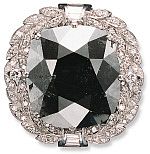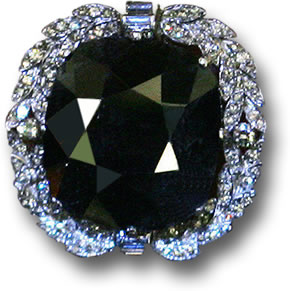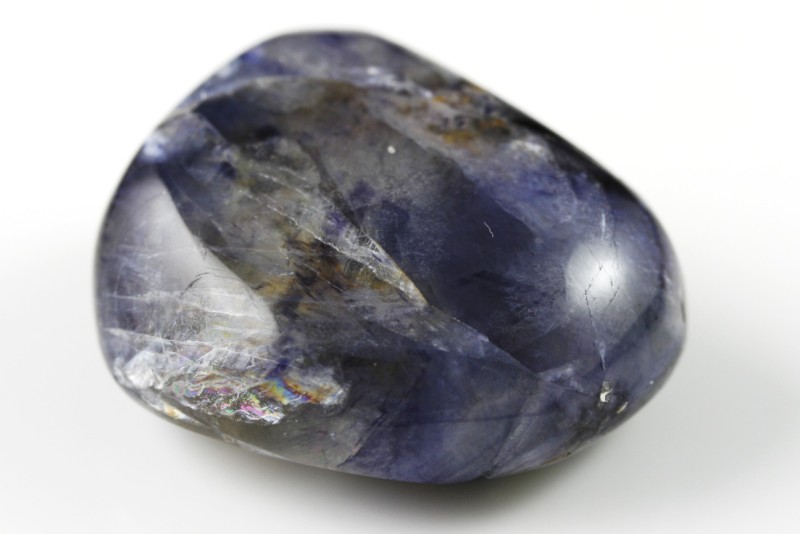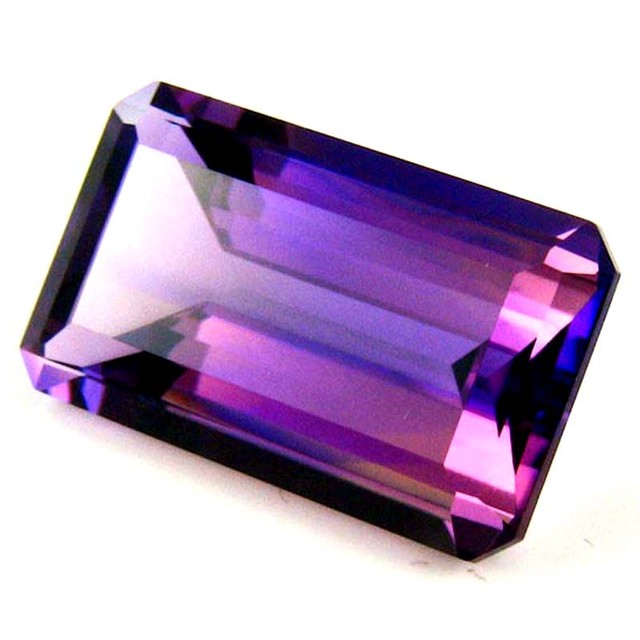According to the legend, the Black Orlov is said to have taken its name from the Russian Princess Nadia Vyegin-Orlov who owned it for time during the mid-eighteenth century. It is a 67.50-carat cushion-cut stone, a so-called black diamond (actually, a very dark gun-metal color). It is reported to have belonged to a nineteenth-century shrine near Pondicherry, India, and to have weighed 195 carats in the rough. Unfortunately the Indian origin of this stone is almost certainly false. There is no documentation of Russia having had a princess by that name or of India having produced any black diamonds of note.
The stone has been exhibited widely, including at the American Museum of Natural History in 1951, the Wonderful World of Fine Jewellery & Gifts at the 1964 Texas State Fair, Dallas and the Diamond Pavilion in Johannesburg in 1967.
The Black Orlov was owned by Charles F. Winson, New York City gem dealer, who valued it at $150,000. It is mounted in a modern diamond-and-platinum necklace. An alternate name is the Eye of Brahma Diamond. In 1969, the stone was sold for $300,000. It was resold in 1990 at Sothebys for $99,000. On October 11th, 2006, the necklace containing the stone figured as lot #433 in a Christie’s Magnificent Jewels sale where it sold for $352,000. Its estimate had been $100,000 to $200,000.
The Curse of the Black Orlov
Often mistaken to be black in color, the hypnotic deep “gun-metal” tones of this legendary black diamond struggle to hide the reflections of a very dark past, starting with a theft from a Hindu idol and resulting in no less than 3 mysterious suicides.
The Black Orlov Diamond, also known as the Eye of Brahma Diamond, weights 67.50 carats and was once part of a much larger uncut 195 carat diamond which can be traced back to 19th century India. Legend has it that the uncut stone originally featured as one of the eyes in a statue of the Brahma, the Hindu God of creation, which stood in a shrine in the southern city of Pondicherry. It is believed that here the diamond was stolen from the statue by a travelling monk after which it became cursed.
Whilst many are sceptical about the existence of such a curse and its beginnings are thought to be little more than folklore, the journey of the diamond from here on is still one shrouded in mystery, drama and death.
In 1932 the diamond found its way to the United States, imported by a European diamond dealer named Mr J.W. Paris who was in search of a buyer. Little is known about J.W. Paris but within a week of arriving in New York he had sold the diamond, and shortly after, on April 7th of that same year, he made his way to the top of a Manhattan skyscraper, in the heart of 5th Avenue, and jumped to his death, becoming what some say to be the first known victim of the diamond’s curse.
It is rumoured that J.W. Paris had been suffering from extreme anxiety due to business worries, and that two letters were found in his possession at the time of his death, one addressed to his wife and the other to a fellow jeweller, but no details of either contents were ever made public.
Going back to the turn of the 20th Century, the diamond was in the possession of a royal Russian heir named Princess Nadia Vygin-Orlov. It is from here the black diamond gets its name, but after a much later incident from where the legend is born.
During the 1917 Russian revolution Princess Nadia fled Russia to the safety of Rome, Italy, as did many Russian royals at the time. It was some time later, December 2nd 1947 to be precise, some 15 years after the tragic death of J.W. Paris, when Princess Nadia leaped to her death from a building in central Rome, in what was believed to have been a suicide. At the time of her death the Princess was the wife of a Russian Jeweller, but little more is known as to why she took her own life.
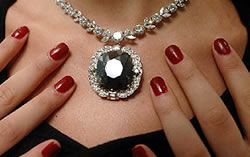 Only one month previous to Princess Nadia’s death another member of Russian royalty, Princess Leonila Viktorovna-Bariatinsky had leaped to her death, in what again was believed to be a suicide. At the time of her death Princess Leonila was married to Royal Navy Officer Prince Andre Glinstine, but no further details are on record as to what brought about her fatal jump, although it was later discovered that previous to her death she had been the owner of this now infamous precious stone, the Black Orlov Diamond.
Only one month previous to Princess Nadia’s death another member of Russian royalty, Princess Leonila Viktorovna-Bariatinsky had leaped to her death, in what again was believed to be a suicide. At the time of her death Princess Leonila was married to Royal Navy Officer Prince Andre Glinstine, but no further details are on record as to what brought about her fatal jump, although it was later discovered that previous to her death she had been the owner of this now infamous precious stone, the Black Orlov Diamond.
Along with the Black Orlov, a second diamond was said to have haunted the Orlov family, one which went on to be known as the White Orlov Diamond. The White Orlov was a 180.60 carat white diamond which was passed on to Catherine the Great by her secret lover, Count Grigori Grigorievich Orlov.
At the time Count Grigori was thought to be completely infatuated by the Grand Duchess Catherine, and had given the diamond as a symbol of his devotion to her, with desperate hope to steal her away from her then husband, Emperor Peter III. Once the diamond had been accepted, Count Grigori plotted the assassination of Peter III, lifting Catherine to become the Empress of Russia, later to be known as the longest ruling female leader of the country.
But things didn’t end well for Count Girgori and he was spurned by Catherine. Girgori left Russia but struggled to deal with his unrequited love for the now Russian leader, and in 1781 Count Grigori returned home, where he went insane and died in Moscow the following year.
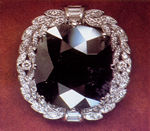 In the 1950s, in an attempt to finally break the curse, the diamond was re-cut by an Austrian Jeweller, at the request of it’s then owner, Charles F. Wilson. The cutting itself took two years but it was deemed a successful venture in terms of shedding the precious stone of its demons.
In the 1950s, in an attempt to finally break the curse, the diamond was re-cut by an Austrian Jeweller, at the request of it’s then owner, Charles F. Wilson. The cutting itself took two years but it was deemed a successful venture in terms of shedding the precious stone of its demons.
The diamond has since passed through the hands of several private dealers, none of whom have yet to have been affected by the curse. The 67.50 carat Black Orlov currently sits in a 108-diamond brooch, suspended from a 124-diamond necklace, and has even made an appearance at the Oscars, being worn by actresses Felicity Huffman, star of the hit TV series and movie Desperate Housewives.
Credit: GemSelect.com


